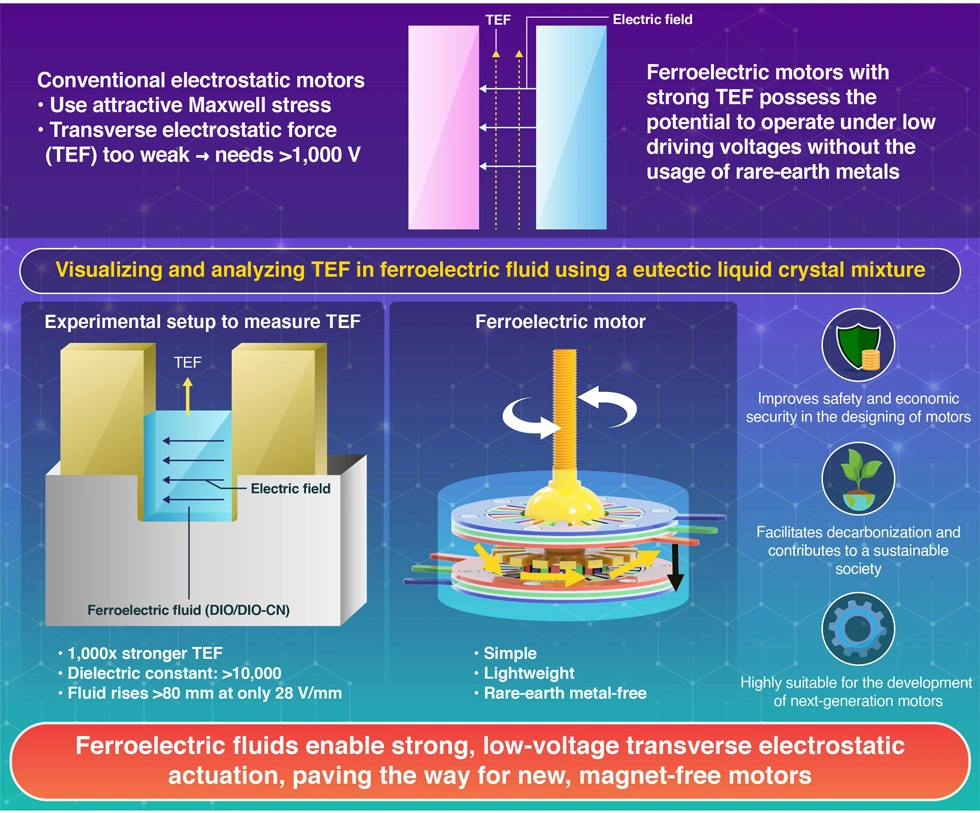A new era of electrostatic actuation powered by ferroelectric fluids
Visualizing transverse electrostatic forces in ferroelectric fluids for the production of next-generation motors
Researchers have discovered that ferroelectric fluids can harness an overlooked transverse electrostatic force (TEF) to rise over 80 mm, without magnets or high voltages. By exploiting the fluid’s spontaneous polarization and exceptionally high dielectric constant, they achieved a strong TEF, previously thought unattainable in conventional electrostatics. This breakthrough enables creation of a lightweight, magnet-free motor, opening possibilities for compact, energy-efficient actuators and suggesting a transformative approach to converting electrical energy into mechanical motion at low voltages.
Turning Polarization into Motion: Ferroelectric Fluids Redefine Electrostatic Actuators

Actuators—devices that convert energy into motion—are at the heart of modern motion systems, from microelectromechanical devices to robotics. Among them, electrostatic actuators stand out for their precision, rapid response, and compatibility with microelectromechanical systems. They operate by applying an electric field between two electrodes, creating an attractive pressure known as Maxwell stress.
However, their dependence on this electrostatic attraction demands high voltages to produce meaningful motion. Another component, the transverse electrostatic force (TEF), acts perpendicularly to the field but was long considered too weak to be useful. Consequently, electrostatic actuators remained limited to small, high-voltage applications, while high-power systems relied on electromagnetic or piezoelectric mechanisms.
This limitation began to change with the discovery of polar nematic liquid crystals, a breakthrough that redefined what electrostatic materials could achieve. These ferroelectric nematic liquid crystals combine the free-flowing nature of liquids with spontaneous polarization, allowing their molecules to align collectively and retain an internal electric dipole. Remarkably, their dielectric constants can exceed those of typical dielectrics by several thousand times, enabling the generation of substantial mechanical stress under modest voltages.
Building on this, a research team led by Specially Appointed Professor Suzushi Nishimura and Researcher Tatsuhiro Tsukamoto from the School of Materials and Chemical Technology, Institute of Science Tokyo (Science Tokyo), Japan, set out to determine whether ferroelectric nematic liquid crystals could harness and amplify the long-overlooked TEF. Their goal was to demonstrate a new kind of ferroelectric motor powered purely by electrostatic forces. The results of their study were published in Communications Engineering on November 19, 2025.
For their experiments, the team used a ferroelectric nematic mixture of DIO and DIO-CN, a eutectic liquid crystal blend with a stable ferroelectric phase between 22 °C and 52 °C. Two parallel stainless-steel rulers—to function as electrodes—were placed inside a reservoir filled with the ferroelectric fluid. A direct current electric voltage was applied to the electrodes, with precise temperature control via a thermocouple, while high-speed cameras captured the fluid’s motion.
The results were striking. As the electric field intensified, the liquid began to rise, first gradually, then dramatically. At just 28 V/mm, the column of liquid lifted more than 80 mm, visibly demonstrating the strength of the TEF. This motion corresponded to a stress exceeding 1,000 N/m2, achieved at voltages thousands of times lower than those required by conventional electrostatic actuators. Control fluids, such as silicone oil and 4-cyano-4’-pentylbiphenyl, showed no movement, confirming that the effect was unique to the ferroelectric nature of the DIO/DIO-CN mixture.
Electrical measurements revealed a smooth transition from the paraelectric to the ferroelectric state, confirming that the amplified force originated from spontaneous polarization rather than standard dielectric behavior. Repeated trials demonstrated the force’s stability and reproducibility, proving it could sustain continuous operation.
Nishimura says, “By using a ferroelectric nematic liquid crystal whose dielectric constant and polarization are over a thousand times greater than those of conventional materials, we drastically reduced the required driving voltage, from around 10 kV to just a few tens of volts. Moreover, by harnessing the electrostatic force acting perpendicular to the applied electric field, we were able to construct a rotor made entirely of plastic.” This design not only simplifies the motor’s structure but also enables a lightweight, rare-earth metal-free, and sustainable build.
This work represents a major leap in actuator design, introducing lightweight, magnet-free, and low-voltage devices that are both energy-efficient and environmentally sustainable. Reflecting on its significance, Nishimura notes, “As the global transition toward decarbonization accelerates and electric energy becomes a dominant power source, ferroelectric motors, free from rare-earth elements and operable at low voltages, are expected to contribute to a sustainable and resilient society, with improved economic security as next-generation technology in Japan.”
By revealing and harnessing the TEF within ferroelectric fluids, this study not only advances electrostatic engineering but redefines its potential.
Reference
- Authors:
- Tatsuhiro Tsukamoto and Suzushi Nishimura
- Title:
- Huge transverse Maxwell stress in ferroelectric fluids and prototyping of new ferroelectric motors
- Journal:
- Communications Engineering
- Affiliations:
- School of Materials and Chemical Technology, Institute of Science Tokyo, Japan
Related articles
Further information
Specially Appointed Professor Suzushi Nishimura
Contact
Public Relations Division, Institute of Science Tokyo
- Tel
- +81-3-5734-2975
- media@adm.isct.ac.jp